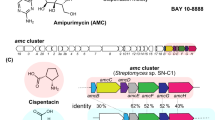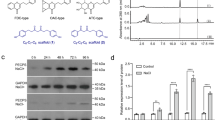Abstract
Bacteria use modular polyketide synthases (PKSs) to assemble complex polyketides, many of which are leads for the development of clinical drugs, in particular anti-infectives and anti-tumoral agents1. Because these multifarious compounds are notoriously difficult to synthesize, they are usually produced by microbial fermentation. During the past two decades, an impressive body of knowledge on modular PKSs2,3 has been gathered that not only provides detailed insight into the biosynthetic pathways but also allows the rational engineering of enzymatic processing lines to yield structural analogues4,5. Notably, a hallmark of all PKS modules studied so far is the head-to-tail fusion of acyl and malonyl building blocks, which leads to linear backbones. Yet, structural diversity is limited by this uniform assembly mode. Here we demonstrate a new type of PKS module from the endofungal bacterium Burkholderia rhizoxinica that catalyses a Michael-type acetyl addition to generate a branch in the carbon chain. In vitro reconstitution of the entire PKS module, X-ray structures of a ketosynthase-branching didomain and mutagenesis experiments revealed a crucial role of the ketosynthase domain in branching the carbon chain. We present a trapped intermediary state in which acyl carrier protein and ketosynthase are covalently linked by the branched polyketide and suggest a new mechanism for chain alkylation, which is functionally distinct from terpenoid-like β-branching. For the rice seedling blight toxin rhizoxin, one of the strongest known anti-mitotic agents, the non-canonical polyketide modification is indispensable for phytotoxic and anti-tumoral activities. We propose that the formation of related pharmacophoric groups follows the same general scheme and infer a unifying vinylogous branching reaction for PKS modules with a ketosynthase-branching–acyl-carrier-protein architecture. This study unveils the structure and function of a new PKS module that broadens the biosynthetic scope of polyketide biosynthesis and sets the stage for rationally creating structural diversity.
This is a preview of subscription content, access via your institution
Access options
Subscribe to this journal
Receive 51 print issues and online access
$199.00 per year
only $3.90 per issue
Buy this article
- Purchase on Springer Link
- Instant access to full article PDF
Prices may be subject to local taxes which are calculated during checkout




Similar content being viewed by others
References
Fischbach, M. A. & Walsh, C. T. Assembly-line enzymology for polyketide and nonribosomal peptide antibiotics: logic, machinery, and mechanisms. Chem. Rev. 106, 3468–3496 (2006)
Khosla, C., Kapur, S. & Cane, D. E. Revisiting the modularity of modular polyketide synthases. Curr. Opin. Chem. Biol. 13, 135–143 (2009)
Keatinge-Clay, A. T. The structures of type I polyketide synthases. Nat. Prod. Rep. 29, 1050–1073 (2012)
Weissman, K. J. & Leadlay, P. F. Combinatorial biosynthesis of reduced polyketides. Nature Rev. Microbiol. 3, 925–936 (2005)
Wong, F. T. & Khosla, C. Combinatorial biosynthesis of polyketides–a perspective. Curr. Opin. Chem. Biol. 16, 117–123 (2012)
Hertweck, C. The biosynthetic logic of polyketide diversity. Angew. Chem. Int. Ed. Engl. 48, 4688–4716 (2009)
Khosla, C. Structures and mechanisms of polyketide synthases. J. Org. Chem. 74, 6416–6420 (2009)
Wilson, M. C. & Moore, B. S. Beyond ethylmalonyl-CoA: the functional role of crotonyl-CoA carboxylase/reductase homologs in expanding polyketide diversity. Nat. Prod. Rep. 29, 72–86 (2012)
Calderone, C. T. Isoprenoid-like alkylations in polyketide biosynthesis. Nat. Prod. Rep. 25, 845–853 (2008)
Partida-Martinez, L. P. & Hertweck, C. Pathogenic fungus harbours endosymbiotic bacteria for toxin production. Nature 437, 884–888 (2005)
Scherlach, K., Busch, B., Lackner, G., Paszkowski, U. & Hertweck, C. Symbiotic cooperation in the biosynthesis of a phytotoxin. Angew. Chem. Int. Ed. Engl. 51, 9615–9618 (2012)
Scherlach, K., Partida-Martinez, L. P., Dahse, H.-M. & Hertweck, C. Antimitotic rhizoxin derivatives from cultured symbionts of the rice pathogenic fungus Rhizopus microsporus. J. Am. Chem. Soc. 128, 11529–11536 (2006)
Hong, J. & White, J. D. The chemistry and biology of rhizoxins, novel antitumor macrolides from Rhizopus chinensis. Tetrahedron 60, 5653–5681 (2004)
Schmitt, I. et al. Evolution of host-resistance in a toxin-producing fungal-bacterial mutualism. ISME J. 2, 632–641 (2008)
Kusebauch, B., Scherlach, K., Kirchner, H., Dahse, H. M. & Hertweck, C. Antiproliferative effects of ester- and amide-functionalized rhizoxin derivatives. ChemMedChem 6, 1998–2001 (2011)
Lackner, G., Moebius, N., Partida-Martinez, L. P. & Hertweck, C. Complete genome sequence of Burkholderia rhizoxinica, an Endosymbiont of Rhizopus microsporus. J. Bacteriol. 193, 783–784 (2011)
Lackner, G., Moebius, N., Partida-Martinez, L. P., Boland, S. & Hertweck, C. Evolution of an endofungal lifestyle: deductions from the Burkholderia rhizoxinica genome. BMC Genomics 12, 210 (2011)
Partida-Martinez, L. P. & Hertweck, C. A gene cluster encoding rhizoxin biosynthesis in Burkholderia rhizoxina, the bacterial endosymbiont of the fungus Rhizopus microsporus. ChemBioChem 8, 41–45 (2007)
Kusebauch, B., Busch, B., Scherlach, K., Roth, M. & Hertweck, C. Polyketide-chain branching by an enzymatic Michael addition. Angew. Chem. Int. Ed. Engl. 48, 5001–5004 (2009)
Dorrestein, P. C. et al. Facile detection of acyl and peptidyl intermediates on thiotemplate carrier domains via phosphopantetheinyl elimination reactions during tandem mass spectrometry. Biochemistry 45, 12756–12766 (2006)
Tsai, S.-C. & Ames, B. D. Structural enzymology of polyketide synthases. Methods Enzymol. 459, 17–47 (2009)
Maier, T., Leibundgut, M. & Ban, N. The crystal structure of a mammalian fatty acid synthase. Science 321, 1315–1322 (2008)
Crawford, J. M. et al. Structural basis for biosynthetic programming of fungal aromatic polyketide cyclization. Nature 461, 1139–1143 (2009)
Bretschneider, T. et al. A ketosynthase homolog uses malonyl units to form esters in cervimycin biosynthesis. Nature Chem. Biol. 8, 154–161 (2011)
Fuchs, S. W. et al. Formation of 1,3-cyclohexanediones and resorcinols catalyzed by a widely occuring ketosynthase. Angew. Chem. Int. Ed. Engl. 52, 4108–4112 (2013)
Piel, J. Biosynthesis of polyketides by trans-AT polyketide synthases. Nat. Prod. Rep. 27, 996–1047 (2010)
Lim, S. K. et al. iso-Migrastatin, migrastatin, and dorrigocin production in Streptomyces platensis NRRL 18993 is governed by a single biosynthetic machinery featuring an acyltransferase-less type I polyketide synthase. J. Biol. Chem. 284, 29746–29756 (2009)
Wang, B. et al. Biosynthesis of 9-methylstreptimidone involves a new decarboxylative step for polyketide terminal diene formation. Org. Lett. 15, 1278–1281 (2013)
Rajski, S. R. & Shen, B. Multifaceted modes of action for the glutarimide-containing polyketides revealed. ChemBioChem 11, 1951–1954 (2010)
Jez, J. M., Ferrer, J. L., Bowman, M. E., Dixon, R. A. & Noel, J. P. Dissection of malonyl-coenzyme A decarboxylation from polyketide formation in the reaction mechanism of a plant polyketide synthase. Biochemistry 39, 890–902 (2000)
Horn, U. et al. High volumetric yields of functional dimeric miniantibodies in Escherichia coli, using an optimized expression vector and high-cell-density fermentation under non-limited growth conditions. Appl. Microbiol. Biotechnol. 46, 524–532 (1996)
McCoy, A. J. et al. Phaser crystallographic software. J. Appl. Crystallogr. 40, 658–674 (2007)
Söding, J., Biegert, A. & Lupas, A. N. The HHpred interactive server for protein homology detection and structure prediction. Nucleic Acids Res. 33, W244–W248 (2005)
Winn, M. D. et al. Overview of the CCP4 suite and current developments. Acta Crystallogr. D 67, 235–242 (2011)
Tang, Y., Kim, C. Y., Mathews, I. I., Cane, D. E. & Khosla, C. The 2.7-angstrom crystal structure of a 194-kDa homodimeric fragment of the 6-deoxyerythronolide B synthase. Proc. Natl Acad. Sci. USA 103, 11124–11129 (2006)
Terwilliger, T. C. Maximum-likelihood density modification. Acta Crystallogr. D 56, 965–972 (2000)
Emsley, P., Lohkamp, B., Scott, W. G. & Cowtan, K. Features and development of Coot. Acta Crystallogr. D 66, 486–501 (2010)
Murshudov, G. N. et al. REFMAC5 for the refinement of macromolecular crystal structures. Acta Crystallogr. D 67, 355–367 (2011)
Kabsch, W. Automatic processing of rotation diffraction data from crystals of initially unknown symmetry and cell constants. J. Appl. Crystallogr. 26, 795–800 (1993)
Adams, P. D. et al. PHENIX: a comprehensive Python-based system for macromolecular structure solution. Acta Crystallogr. D 66, 213–221 (2010)
Winn, M. D., Isupov, M. N. & Murshudov, G. N. Use of TLS parameters to model anisotropic displacements in macromolecular refinement. Acta Crystallogr. D 57, 122–133 (2001)
Chen, V. B. et al. MolProbity: all-atom structure validation for macromolecular crystallography. Acta Crystallogr. D 66, 12–21 (2010)
Schrodinger, L. L. C. The PyMOL Molecular Graphics System, Version 1.5.0.4. (2010)
Acknowledgements
We thank A. Perner for mass specrometry analyses, H. Heineke for NMR measurements, S. Schneider for preliminary studies on the PPTase, and U. Knüpfer for help in protein production. We thank the DFG for financial support (SFB 766) and the Swiss Light Source beamline X06DA for offering beamtime. D.H. is financially supported by a stipend of the Studienstiftung des Deutschen Volkes.
Author information
Authors and Affiliations
Contributions
T.B., G.Z. and C.H. designed experiments, T.B., R.W. and B.B. performed genetic and biochemical experiments and analysed data, D.H. and B.K. synthesized substrates and reference compounds, J.B.H., T.S. and G.Z. conducted protein crystallization, X-ray analyses and modelling, T.B., G.Z. and C.H. wrote the manuscript.
Corresponding authors
Ethics declarations
Competing interests
The authors declare no competing financial interests.
Supplementary information
Supplementary Information
This file contains Supplementary Results and Discussion, Supplementary Materials and Methods, Supplementary Figures 1-13, Supplementary Tables 1-2 and additional references. (PDF 1590 kb)
Rights and permissions
About this article
Cite this article
Bretschneider, T., Heim, J., Heine, D. et al. Vinylogous chain branching catalysed by a dedicated polyketide synthase module. Nature 502, 124–128 (2013). https://doi.org/10.1038/nature12588
Received:
Accepted:
Published:
Issue Date:
DOI: https://doi.org/10.1038/nature12588
This article is cited by
-
Discovery and biosynthetic pathway analysis of cyclopentane–β-lactone globilactone A
Nature Synthesis (2023)
-
No job too small for a giant enzyme
Nature Chemical Biology (2023)
-
Enzymology of assembly line synthesis by modular polyketide synthases
Nature Chemical Biology (2023)
-
AvmM catalyses macrocyclization through dehydration/Michael-type addition in alchivemycin A biosynthesis
Nature Communications (2022)
-
Genome-based discovery and total synthesis of janustatins, potent cytotoxins from a plant-associated bacterium
Nature Chemistry (2022)
Comments
By submitting a comment you agree to abide by our Terms and Community Guidelines. If you find something abusive or that does not comply with our terms or guidelines please flag it as inappropriate.



